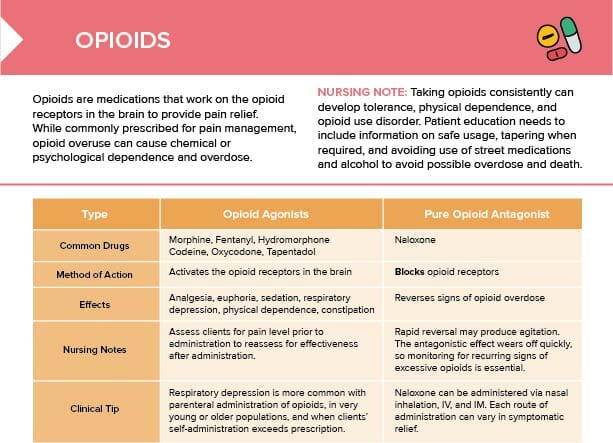What are opioids?
Opioids are medications that work on the opioid receptors in the brain to provide pain relief. The term includes prescription drugs for pain relief and anesthesia as well as illegal drugs not used medically, like heroin.
List of commonly used opioids
- Morphine
- Fentanyl
- Hydromorphone
- Codeine
- Oxycodone
- Tapentadol
- Hydrocodone
- Buprenorphine
- Methadone
- Tramadol
- Meperidine
Related videos
What are opioids used for?
Opioids are prescribed for pain relief in cases of moderate to severe pain that may not respond well to other pain medications.
Due to the euphoric effects, opioids are frequently misused. The potential for physical dependence has led to significant public health issues in North America and other parts of the world, namely an ongoing epidemic of addiction, known as the “opioid crisis.”
How do opioids work?
Opioids bind to the opioid receptors in the brain (spinal cord and digestive tract as well), decreasing the amount of pain signals that the body sends to the brain and therefore reducing the perception of pain.
Opioid antagonists block the opioid receptors.
Nursing note: Assess clients for pain level prior to administration to reassess for effectiveness after administration.
How long do opioids stay in your system?
The length of time an opioid can be detected in the body can vary greatly depending upon the type of opioid, method of use, and other factors. Generally, opioids can be detected in urine for 1–4 days after use. Certain opioids, such as methadone, can be detected for up to a week. Hair tests can potentially detect opioid use for up to 90 days or more.
Opiates vs opioids: what is the difference?
The terms “opioids” and “opiates” are often used interchangeably, but they do technically refer to different substances:
- Opiates: referring to the natural opioids derived from the opium poppy
- Opioids: broader term including natural and synthetic substances
What are the effects of opioids?
Effects of opioids:
- Analgesia
- Euphoria
- Sedation
- Respiratory depression
- Constipation
- Physical dependence: Taking opioids consistently can develop tolerance, physical dependence, and opioid use disorder.
Signs of opioid overdose
Classic triad of signs of opioid overdose:
- Pinpoint pupils
- Respiratory depression
- Coma
Treat with an opioid antagonist. Naloxone can be administered via nasal inhalation, IV, and IM. Each route of administration can vary in symptomatic relief.
How to prevent respiratory depression
Respiratory depression is more common with parenteral administration of opioids in very young or older populations and when clients’ self-administration exceeds prescription. To prevent respiratory depression, naloxone can be administered via nasal inhalation, IV, and IM. Rapid reversal may produce agitation. The antagonistic effect wears off quickly, so monitoring for recurring signs of excessive opioids is essential.
Why are opioids addictive?
Key reasons why opioids can be addictive:
- Build-up of tolerance: higher doses needed in shorter time frames to achieve same effect
- Physical dependence: body/brain adapt to opioids over time; reduction or stopping the drug results in withdrawal symptoms
- Cravings
How can clients be educated on safe usage of opioids to avoid dependence and overdose?
- Client education on safe usage of opioids should include information on avoiding the use of street medications and alcohol to avoid possible overdose and death.
- Clients should also be informed about the risks of opioid overuse causing chemical or psychological dependence and overdose.
- Tapering when required is also important.
Symptoms of opioid withdrawal
Symptoms of opioid withdrawal include:
- Fever
- Insomnia
- Lacrimation
- Pupillary dilation
- Anxiety
- Tremors
- GI upset
What are synthetic opioids?
Opioids can be divided into categories according to their origin:
- Natural: alkaloids from the resin of the opium poppy (e.g. morphine)
- Semi-synthetic: made in labs from natural opioids (e.g. oxycodone)
- Synthetic: entirely man-made (e.g. fentanyl, methadone)

